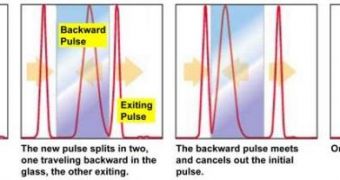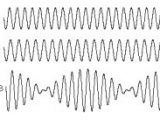Physicists really seem to have done it this time. They sent a light pulse through an optical fiber and the pulse exits the fiber before it enters it! "I've had some of the world's experts scratching their heads over this one," says Robert Boyd, a professor of optics at the University of Rochester. "It's weird stuff."
The best explanation they could come up with was that somehow, as the light pulse approaches the fiber, two other pulses spontaneously form at the other end, one exiting the fiber and the other one going backwards to meet the original pulse and to annihilate it.
But how does this fit with the conservation of energy? And how about Einstein's idea that things don't go faster than the "speed of light", not even light itself!
This is how Boyd himself puts it: "We sent a pulse through an optical fiber, and before its peak even entered the fiber, it was exiting the other end. Through experiments we were able to see that the pulse inside the fiber was actually moving backward, linking the input and output pulses."
"The pulse of light is shaped like a hump with a peak and long leading and trailing edges. The leading edge carries with it all the information about the pulse and enters the fiber first. By the time the peak enters the fiber, the leading edge is already well ahead, exiting. From the information in that leading edge, the fiber essentially 'reconstructs' the pulse at the far end, sending one version out the fiber, and another backward toward the beginning of the fiber."
A statement issued by the University of Rochester also writes: "As the pulse enters the material, a second pulse appears on the far end of the fiber and flows backward. The reversed pulse not only propagates backward, but it releases a forward pulse out the far end of the fiber. In this way, the pulse that enters the front of the fiber appears out the end almost instantly, apparently traveling faster than the regular speed of light."
However, the key word in the last sentence above is "apparently". What Boyd and his team did was to really push to its limits a well known aspect of light (which is known since the 19th century actually): Light is supposed to be a wave. But in the same time it comes in packages - photons. These packages are supposed to result out of a combination of waves superimposing each other (see image). However, the things that really exist and that move at the speed of light are the photons (the packages that carry around the energy) and not the waves (waves are theoretical tools). Boyd's experiment doesn't affect the physics of photons at all.
A spokesperson at the university's communications department did underline it: "Everything that defines the pulse that enters, also defines the pulse that exits. But the energy of the light [i.e. the photons] does not travel faster than light."
The idea is that the velocity of these abstract waves is linked (this is what the electromagnetic theory says) to the properties of the material (in the same way as for instance the speed of sound depends on the material - e.g. sound travels faster in water than through air). So, what Boys and his team did was to make the speed of these electromagnetic waves to be as different as possible from the "group velocity" - the actual speed of light (of the photons).
So, his experiment does look weird, but it doesn't really break any known law of physics, it just pushes them to their limits of oddity. See an animated simulation of the effect here.
(You might want to ask: Ok, so what's the true explanation? Boyd's explanation is the true explanation because the electromagnetic theory is an extremely well verified theory, its predictions are incredibly accurate - I would say one hundred percent accurate, but I'm afraid you wouldn't believe me. But even so, you shouldn't take the ideas of waves very seriously, as if they "really" exist - they still are only theoretical means for explaining, and they do explain, how photons move around - and photons move around in rather strange ways.)
Image credit: University of Rochester

 14 DAY TRIAL //
14 DAY TRIAL // 
